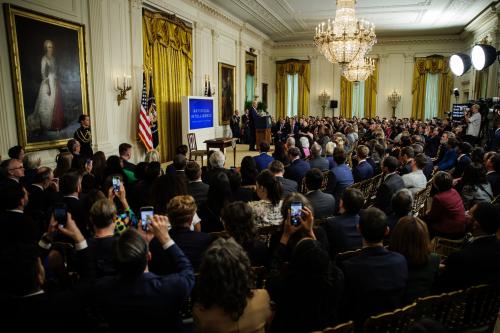Norman Ornstein and Anthony Corrado took to the pages of The Washington Post on the fifth anniversary of the Bipartisan Campaign Reform Act of 2002, known widely as the McCain-Feingold law, to argue that the modest aspirations of the bill have been largely realized, that the widespread forecast of its critics that political parties would be debilitated and incumbents further advantaged have proven inaccurate, and that grassroots political activity and small-donor fundraising are thriving in the post-BCRA regulatory environment. (Full disclosure: Ornstein and Corrado are my personal friends and frequent collaborators on a range of subjects, including campaign finance reform.) In my view, their argument was measured and reasonable. To critics Robert Bauer and John Samples, however, it was delusional.
The exchange underscores the continuing incapacity of proponents and opponents of campaign finance regulation to concede an inch of ground. A deep philosophical divide produces Rashomon-like divergences in describing, explaining, and evaluating campaign finance practices and reforms. Those of us who considered ourselves at the political center of the campaign finance debate (Ornstein, Corrado, Michael Malbin, and myself, all members of the working group that sought successfully to scale back McCain-Feingold to deal with what we took to be obvious endruns around existing law governing party, corporate and union funding of federal elections, as well as Frank Sorauf), found the center disappearing here as well as in the rest of American politics.
I am pleased that I have cordial relations with Bob Bauer and John Samples and take our differences to be principled and sincere. But there is no denying that we often see a different set of facts and almost always interpret those facts in fundamentally different ways.
Bauer asserts that BCRA assured the collapse of the presidential public funding system, presumably because of the increase in the maximum individual contribution without a corresponding increase in the public match. I see something very different. Before BCRA, George Bush became the first successful presidential candidate to opt out of public funding in the nomination stage. He certainly would have done so again in 2004 without BCRA. Howard Dean’s decision to op out in 2004 was due to his success at small-donor fundraising, not because of the higher individual contribution limit. Kerry’s decision to follow was likewise unrelated to BCRA. Does anyone believe that McCain, Romney, Giuliani, Clinton, Obama, or Edwards would have accepted public financing in 2008 if BCRA were not on the books? The presidential public financing system is hopelessly out of date, as reformers have argued for many years. With a Republican president and Congress at the time BCRA was being debated, it was deemed (correctly in my view) politically impossible to update the system to make it attractive to candidates.
While Bauer sees BCRA as the straw that broke the camel’s back of public funding (presumably a bad thing), he dismisses any role for BCRA in the increase in small donors (a good thing). Ornstein and Corrado, he asserts, mistakenly ignore small donor trends in progress at the time the law was passed. (But it’s okay to ignore trends in progress in public financing and find a pivotal role for BCRA?) Yes, of course, the rise of the Internet has facilitated small-donor fundraising. But shouldn’t we take former DNC Chairman Terry McAuliffe at his word when he reports that the prospect of the end of party soft money led him to make a huge investment expanding the party’s small-donor base?
Samples launches a more comprehensive critique of Ornstein and Corrado as well as BCRA. He believes Ornstein and Corrado pull a sleight of hand in their compilation and interpretation of party fundraising statistics before and after BCRA. Had they projected what the parties would have raised without BCRA, they would have discovered parties now actually have fewer resources available. Well, yes, that’s probably correct. But when the bill was being debated and the law constitutionally tested, BCRA critics argued that parties would be devastated, that BCRA was a “Democratic party suicide bill,” and that grassroots political activity would wither on the vine. No such damage was done to the parties. They are playing a more central role in presidential and congressional elections after BCRA than before. And that includes expenditures on grassroots political activities. Both parties invested heavily in data bases and increased their GOTV budgets. Between 1996 and 2002, party soft money did not seed grassroots political activity in the states. It was used mainly for candidate-centered “issue ads.”
Samples argues that Democrats were hurt in 2006 by not having additional (soft money) funds available to compete in a larger number of contests and to build up their party across the board. Maybe yes, maybe no. They invested fully in all of the Senate contests in which they had any chance. In the House, the DCCC had the resources to substantially expand the playing field relative to recent pre-BCRA elections. They were heavily invested in most of the contests they lost by a few percentage points or less. Moreover, Republicans would likely have more than matched the Democrats in soft-money fundraising, thereby negating any advantage these funds might have had. Dean and the DNC, quite apart from the Democratic congressional campaign committees, had enough funds to invest substantially in the 2006 elections and the longer-term party building effort.
A few other facts on which Samples and I disagree. Party soft money was not diverted to 527s. The research on this by the Campaign Finance Institute, reported in The Election After Reform, is crystal clear. BCRA did not ban any political ads; it stipulated that electioneering communications may not be funded by corporations and unions. The amount of political advertising in 2006 supports the view that BCRA did not constrain vibrant free speech. Other research reported in that volume (and in Financing the 2004 Election) supports the modest claims made by Ornstein and Corrado.
Samples judges BCRA by the arguments made in Congress by some of its supporters. I don’t doubt that some wanted to reduce the overall amount of money in campaigns and eliminate negative advertising. But those were not built into the design of the law. BCRA eliminated party soft money, reinstated a longtime prohibition on using corporate and union treasury funding of federal election contributions and expenditures, and restored a small part of the real value of the contribution limits approved in 1974. Modest steps, all implemented as expected by the law’s designers.
Not surprisingly, campaign finance developments in 2004 and 2006 were shaped by a large set of forces in addition to BCRA. This is always the case with institutional and procedural reform and is discussed at length in the two volumes mentioned above. But if you are convinced philosophically that campaign finance regulation cannot work, then you are likely to see it not working; if you judge any regulation of political communication a restraint on free speech, then you will see such speech diminished; if you believe any campaign law written by incumbents will advantage incumbents, then all campaign law will advantage incumbents; if you believe denying a political party an existing revenue source inevitably weakens that party, then BCRA must have weakened the political parties.
My colleagues and I don’t share that libertarian framework and continue to try to grapple with the very difficult problems associated with money and politics. They are no easy solutions to those problems—whatever the claims of reformers or deregulators. Our choices inevitably are influenced by our values and beliefs and the empirical world we see around us.



Commentary
Op-edBipartisan Campaign Reform Act: Success or Failure?
April 10, 2007